Nowadays, technology plays a critical role in business communication. Team communication tools provide a hub for chat, document sharing and collaboration, task management, and voice and video communication, enhancing how team members communicate and work together.
But with so many different types of communication software, you’re sure to have questions. Which tool is right for your team? What should you look for? What are the benefits?
Below we’ll lay it all out. So without further ado…
10 Best Team Communication Tools
1. Brosix
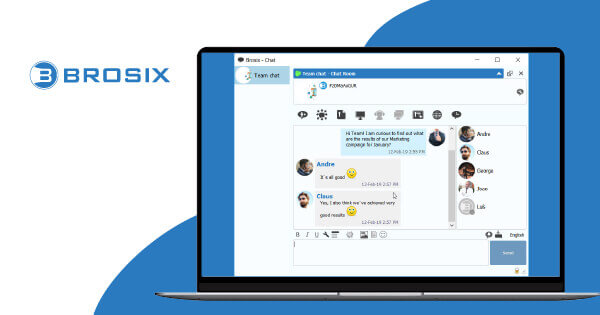
Available on: Windows, macOS, iOS, Android, Linux, and Web
As the builders of Brosix, it only makes sense to start with what we know – Brosix is a highly capable, secure, and customizable communication tool for teams.
Brosix is built for teams of all sizes and kinds. Chat instantaneously via one-to-one text messages, tailor chat rooms to meet specific group requirements, and make crystal clear voice and video calls, all over fully encrypted, peer-to-peer channels on a private team network.
Our rich collaboration features and administrative controls allow you to fully customize and manage the team communication experience. Delegate features and tools on a user or team basis, tailor shared chat spaces and contact lists, authorize multiple team admins, and more.
Top Brosix features:
- Administrative control options
- End-to-end encrypted communication channels
- Fully trackable User Activity Logs
- Searchable chat histories
- Unlimited size file transfers
- Virtual whiteboard conferences
- Screen-sharing with remote desktop control
- Instant screenshots
- The ability to broadcast messages to targeted audiences
Pricing: Free team communication and modest admin control with Startup; $4 user/month for Business; $6 user/month for Premium gets you full control and customization of your team network.
The Verdict: Combining robust, real-time communication and collaboration tools, powerful administrative control options, and best-in-class security, Brosix improves the quality and productivity of teamwork while safeguarding data and information. Take it for a spin and see how it can improve your team communication.
2. Chanty
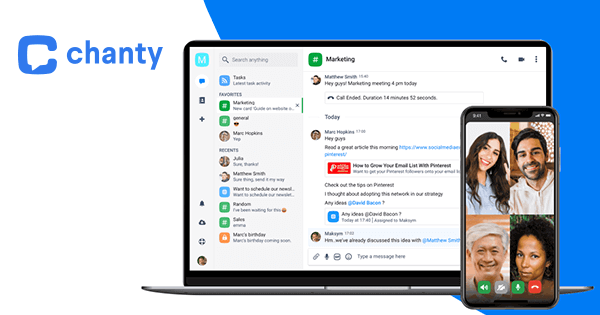
Available on: Windows, macOS, iOS, Android, and Web
One of the newer team communication apps here, Chanty has made a name for itself by offering an unlimited messaging history and AI-powered tools at startup-friendly prices. Chat one-to-one or in public and private channels. For good measure, Chanty throws in voice and video calls, file sharing, screen-sharing, and a hub to organize tasks and conversations.
Top Chanty features:
- AI-powered search and suggestions
- Teambook organizes tasks, messages, links, and files
- Message and task tracking
- Automated workflows through Trello, Mailchimp, and Zapier integrations
Pricing: Free for up to 5 members; Paid plans from $3 per user/month.
The Verdict: Customization options are limited and some features and integrations still aren’t available, but Chanty’s up front about that. That said, the free unlimited messaging history is an obvious slight to Slack. Chanty is an up-and-comer worth keeping an eye on.
3. Slack

Available on: Windows, macOS, iOS, Android, Linux, Web
No doubt the app you’ve probably heard of. While Slack provides the features you need to communicate with team members – instant messaging, voice and video calls, file transfers, and screen-sharing – integrations are its bread and butter and Slack delivers more than two thousand of them.
Top Slack features:
- Over 2000 integrations
- Slack bots can remind you of tasks and messages
- Keyword notifications
- Customizable sidebar and themes
- RSS feed capabilities
Pricing: Slack’s free option limits you to 90 days of shared files and message history access and 10 integrations; Pro from $7.25 user/month; Business + from $12.50 user/month.
The verdict: More than 32 million daily active users will attest that Slack is a worthy team communication tool. It’s got a hip UX and more integrations than anyone.
But Slack’s price point puts it out of reach for many small to mid-sized businesses and startups. Slack’s powerful integrations also mean that many of its capabilities are a result of other tools and technologies. What’s more, questions have been raised surrounding Slack’s handling of user data, as well as the threat that third-party apps can pose.
4. Flock

Available on: Windows, macOS, iOS, Android, Linux, and Web
Born in India, now Flock is aiming at Slack. The team communication tool provides one-on-one and group chat, audio and video calls, task manager, and around 60 integrations.
Top Flock features:
- Built-in task management
- The ability to create auto-generated mailing lists, shared to-do lists, and polls
- 60+ integrations
- The ability to invite guests onto the platform
Pricing: $4.50 user/month for screen-sharing, unlimited messaging history, and 10GB storage per user; Enterprise plan requires contacting sales; A freebie Plan limits you to 10K message history.
The verdict: Flock’s interface isn’t the most user-friendly and there are limited customization options. That said, it’s an affordable option that claims to be faster than Slack.
5. Ryver
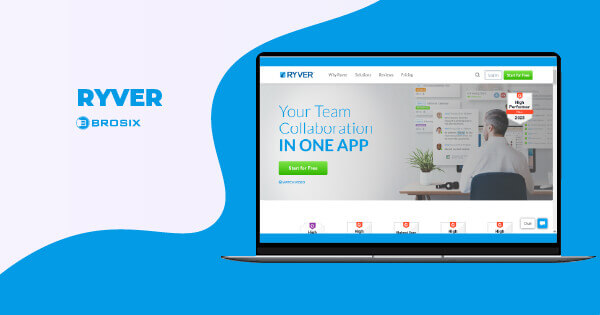
Available on: Windows, macOS, iOS, Android, and Web
Ryver is a communication tool for teams that ups the ante by providing task management on the same platform. Communication happens in direct messages, open forums, or private groups – all of which can be turned into tasks and tracked on a Kanban board.
Top Ryver features:
- Voice and video calls, screen-sharing, and unlimited integrations through Zapier
- Reminders to follow up on messages
- Social media, news, and RSS-feed streaming
- Chat, task management and automated workflows on one platform
Pricing: Plans from $69 per month for up to twelve users; $129 per month for up to 20 users; $4/user for over 30 participants; Enterprise plan upon request. There’s no freemium plan, just a 14-day free trial.
The Verdict: Ryver bucks the trend by charging a flat rate for unlimited users, team communication, and task management on one platform.
Bear in mind, customization options are few and there’s no free plan. And if your team relies on Zapier integrations, get ready to pay up. At $289 for 50K tasks – Zapier plans aren’t cheap.
6. Microsoft Teams
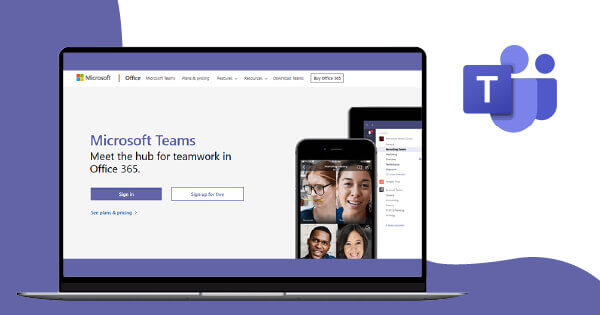
Available on: Windows, macOS, iOS, Android, and Web
Part of the Microsoft 365 and Office 365 packages, Teams is Microsoft’s communication tool geared toward large enterprises. Aside from the usuals – chat, audio and video calls, and screen-sharing – Teams stands out for its deep integration with the Office 365 range of tools, allowing teams to collaborate on virtually any type of document.
Top Teams features:
- Microsoft Office 365 integration
- Team collaboration on Office documents
- In-messaging word-style formatting
- AI-powered functionalities
Pricing: Essentials from $4 user/month; Business Standard from $12.50 user/month. A limited free tool aims to push you toward a Microsoft subscription.
The Verdict: For collaboration on top of Office 365 products, Teams can’t be beat. Same goes if you’re an Office 365 or Microsoft 365 account holder or just happen to be a fan of Microsoft in general. Just have your patience ready when deploying Teams, as well as your credit card – you’ll need a Microsoft account just to access Teams.
7. Troop Messenger
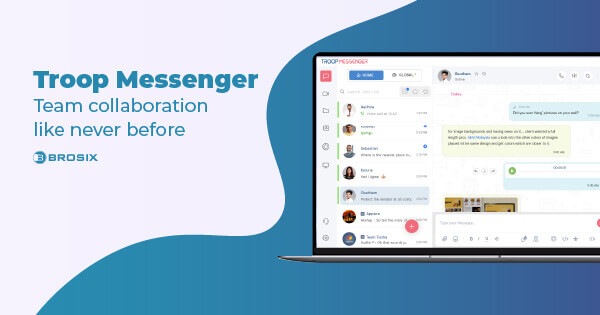
Available on: iOS, Android, Windows, macOS, Linux
Troop’s platform for teams facilitates one-on-one and group communication, as well as audio and video calling and file-sharing but at an affordable price. Enterprise plans get you message-flagging capabilities, burnout chats, data usage analytics, and the option to self-host.
Top Troop features:
- Conversation flagging
- Self-destructing burnout chats
- Unlimited messaging history
- The ability to invite outsiders to the platform
Pricing: Paid plans start at $2.5 user/month; Enterprise plans from $5 user/month.
The Verdict: Troop doesn’t offer a free communication tool, but for just a buck a month who needs it? Troop is great value for the money, but collaboration tools are basically limited to screen-sharing.
8. Discord

Available on: Windows, macOS, iOS, Android, Linux, and Web
Originally a communication app for gamers, Discord has gained fame in the business world for its rich voice capabilities. On Discord, voice communication is always on and the ‘Push to talk’ feature allows you to join a conversation just like a walkie talkie.
Top Discord features:
- Screen-sharing, video conferencing and file-sharing capabilities
- Assign roles and permissions to any member of a channel
- Push-to-talk capabilities
- All workspaces on one interface
Pricing: Discord’s freemium version offers core functionality; Nitro Plans from $9.99/month for bigger file uploads, higher-quality screen resolution, and animated avatars and emojis; Nitro Basic for $2.99.
The Verdict: As a freeware (software that’s available for free) with all your workspaces on one interface, Discord’s a highly usable tool and an attractive option for businesses. Concerns have been raised around security though. As the platform has grown in popularity, cybercriminals have been found lurking on the platform.
For more, explore our Discord deep dive to see how the gaming chat stacks up as a tool for team communication.
9. Workplace by Facebook
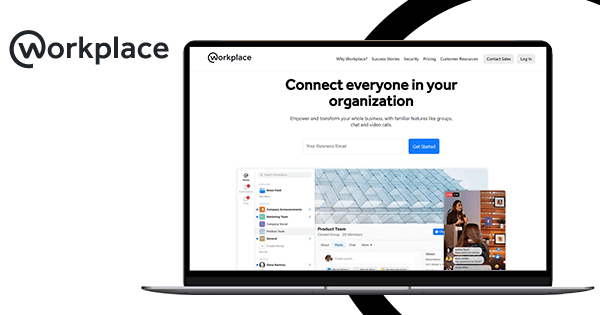
Available on: Windows, macOS, iOS, Android, and Web
No longer just a social media giant, these days Facebook is targeting – you guessed it – Workplaces. Besides direct and group team messaging, the app gets you voice and video calls, monitoring tools for IT teams, admin controls, and some integrations.
For more, here’s our recent Workplace review.
Top Workplace features:
- Live stream company events and get real-time feedback
- The ability to invite customers or teams from outside the organization to the platform
- Unite chat and collaboration with Groups
- Facebook-familiar team communication, collaboration, and culture
Pricing: Paid plans start at $4 per user/month.
The Verdict: Facebook is banking on a familiar UX with Workplace. That means there’s a newsfeed, personal pages, posts, comments, and likes. There’s something to be said for familiarity and ease of use, especially when trying to get your team on board. But at what cost?
Over the years, Facebook has scraped data from Android users, provided millions of users’ personal data to political consulting firms, and even paid teenagers to try apps which then allowed Facebook to harvest their private data. Hardly a sparkling reputation.
If you’re looking for a user-friendly team communication tool that you can trust, try Brosix. Our platform is easy to use and we pay serious attention to the security of user data and information.
10. Fleep

Available on: Windows, macOS, iOS, Android, Web, Linux
With Fleep, you can chat with other Fleep users and teams outside your organization. You don’t get collaboration tools, but Fleep does offer task management and 20 or so integrations like Trello, Jira, Google Drive, and others. Voice and video calls take place through Whereby.
Top Fleep features:
- Unlimited messaging history
- Send emails through the app
- Native task management
Pricing: Free 2-week trial period; $5 per user per month gets you full control over team communication and conversations.
The Verdict: As team communication tools go, Fleep delivers the core chat capabilities you’d expect. If you’re looking for more in the way of collaboration tools or integrations, you’ll need to look elsewhere. What’s more, there’s no native voice or video calling. That happens through Whereby, a browser-based app that’s limited to 12 participants and a handful of browsers.
Let’s recap the purpose and best features of all team tools for effective communication:
| Tool | Best for |
| Brosix | Robust, real-time internal communication and collaboration with strong administrative control options. Suitable for in-office or remote teams of all sizes and kinds. |
| Chanty | Unlimited messaging history and AI-powered tool at startup-friendly prices. Suitable for small to medium-sized teams. |
| Slack | Extensive integrations (2000+) and customizable sidebar and themes. Popular choice for its smooth UX and broad feature set. |
| Flock | Affordable team chat option with built-in task manager and 60 integrations. Targeting Slack’s market with more competitive prices. |
| Ryer | Combining communication with task management on one platform. Flat-rate pricing for unlimited users, suitable for task-oriented teams. |
| Microsoft Teams | Collaboration software on top Office 365 products. Ideal for large enterprises and Microsoft users. |
| Troop Messenger | Affordable team communication software with features like conversation flagging and self-destructing burnout chats. Suitable for budget-conscious teams. |
| Discord | Rich voice capabilities, screen-sharing, and video conferencing tool. Originally for gamers but gained popularity in the business world. |
| Workplace | Familiar UX with features like live streaming company events. Suitable for teams comfortable with Facebook’s interface. |
| Fleep | Core chat capabilities with the ability to chat with users outside your organization. Task manager and integrations available. |
How to Choose the Best Communication Tools for Teams?
With so many apps and tools for team communication, how do you choose the right one? Luckily there are some common criteria to look for when you’re trying out new communication software.
Communication Features
Seems obvious. You’d be surprised how many teams are communicating on separate apps for instant messaging and video calls, not to mention the phone and email. Not only is it not productive. It’s not always secure. But you don’t have to choose between one or the other. The best team communication tools provide text-based communication, voice and video on a single platform. It’s even better if they can be integrated with a project management tool.
Private Team Network
Open chat networks are great for slinging memes and chatting with friends and family. But team communication should be just that… your team. Some platforms allow outsiders like freelancers or clients to join, and that’s a matter for admins, team leads, or managers to decide. If your team isn’t communicating on a private team network, you’ve ceded control of the chat space and opened your business communication to distractions, misbehavior, security risks, or worse.
Security and Privacy
Apps for team communication don’t always take the same approach to security and privacy. Aside from a fully administrable private team network, there are a few things you should look for.
End-to-end encryption over peer-to-peer channels ensures communications flow between authorized users, bypassing potentially vulnerable cloud databases and avoiding possible host misconduct. Use a strong anti-virus and malware program, but also integrate it into the communication platform. When taken as a whole, these steps better safeguard data and information, ensuring your organization’s communications remain in your hands.
Customization and Control
As you know best, no two teams are alike. So why should the chat space be the same? A communication tool does your team no good if it can’t be tailored to meet individual team or business needs. Choose a platform that lets you establish custom chat spaces, handpick administrators, allocate features on a user or team basis, and manage the space from the contact lists all the way down to individual data security levels.
Collaboration Tools
Take stock of what your team really needs to be productive. Some communication tools are bare-bones, giving you chat capabilities but not much more. Others are loaded with bells, whistles, and extras, but come with a steep learning curve. Both instances can hinder team productivity. In many cases, you can get the job done with file sharing, screen-sharing with remote desktop control, instant screenshots, and virtual whiteboards for creativity.
Low Learning Curve
A good team communication app will probably be used more than any other in your office, so make sure both your techies and non-tech types can find their way around the platform and its features with ease. What’s more, make sure it’s easy to deploy. The last thing you want is your IT team jammed up trying to deploy a tool that everyone ends up avoiding.
Cross-functionality
The number one job of a team communication tool is to keep everyone communicating productively. But that can’t happen if the in-house team operating Windows can’t collaborate with the freelancer running Linux. Whatever communication software or tool you choose, make sure it’s optimized across devices, operating systems, browsers, and mobile and desktop platforms.
The Takeaway
When it comes to choosing the right communication tool for your team, there’s no one-size-fits-all formula.
First, evaluate your unique team needs. Then compare them against the features you need to boost productivity and the benefits you most want to realize. Don’t hesitate to test drive a few different internal communication tools. Many offer free versions or trials, which is a great way to evaluate their user-friendliness and core functionalities.
If you’re having trouble making up your mind, give Brosix a look. Guaranteeing communication, collaboration, and control, it’s built to improve how teams communicate.






